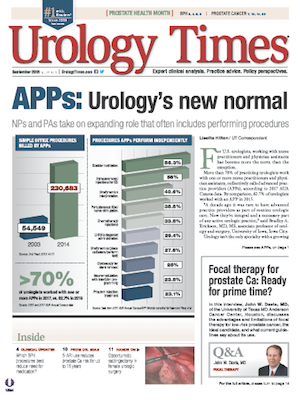Publication
Article
Urology Times Journal
Adequate translation services crucial; here’s why
Author(s):
Failure to provide an interpreter incurs legal and regulatory risk.
According to U.S. Census data, there are at least 25 million people in the United States over the age of 5 years who are considered to be Limited English Proficient, or LEP. This population increased by over 80% between the years of 1990 and 2013
(bit.ly/LEPpopulation).
This simultaneously represents a significant increase in the number of patients presenting for medical care who may not speak or understand English sufficiently.
Cases highlight need for adequate translation
Failure to provide adequate medical interpreter and translation services for patients who are LEP is not only mandated by The Joint Commission and the Affordable Care Act, but it is a clear and present risk for malpractice litigation. A number of cases have been highly publicized in recent years and underscore the importance of using a certified medical interpreter for every patient who needs it.
In 2010, a Spanish-speaking California patient was to undergo a nephrectomy. The patient signed an informed consent that was in English, and was not provided with a copy in Spanish. He did not have access to a Spanish interpreter. The wrong kidney was removed. When the mistake was caught, the diseased kidney was also removed, leaving the patient with no kidneys (bit.ly/translationerror).
In the mid-2000s in Germany, a translation error on the package label of a knee prosthesis required 47 people to undergo repeat knee replacement.
Also by Brianne Goodwin, JD, RN: Specimen errors carry large consequences
In 2015, a Macedonian patient was able to use her friend, rather than a certified medical interpreter, at a consultation for a vestibular nerve tumor. She left with the impression that the tumor was malignant, which was not correct. During surgery, the surgeon severed the patient’s facial nerve, resulting in unilateral palsy. Only after that did she learn that her tumor was not malignant to begin with.
Perhaps the most famous, and costly of all, was the $71 million settlement for an 18-year-old male who presented to an emergency room in a coma. The use of the Spanish word “intoxicado,” which means you ingested something that made you ill, was interpreted as “intoxicated” in English. The patient was treated for drug overdose when he really was suffering a brain hemorrhage. He became a quadriplegic (bit.ly/translationcase).
One study analyzing 35 claims across just four states found that one liability insurer paid $2.3 million in damages or settlements, and $2.8 million in legal fees for situations where a provider failed to provide a professional interpreter (bit.ly/interpreterpolicies).
Next: Clinical, legal risksClinical, legal risks
There is no question that providing high-quality interpreting and translation services comes at a financial cost; a survey by the American Medical Association found that interpreter services might cost $150 or more per visit, an amount that might exceed a physician’s payment for the visit. However, failure to provide these services potentiates clinical and legal risk, as is apparent from the above cases. Regulatory risks loom as well; under the Affordable Care Act a $70,000 fine, per encounter, may be imposed for failing to provide a medical interpreter (bit.ly/properstranslationscarce).
Hospital 30-day readmission rates are higher for LEP patients, which may then lead to reduced federal reimbursement (bit.ly/translationcase, bit.ly/interpreterpolicies). Finally, the Office of Civil Rights has stated that when an LEP patient is denied or delayed care due to language barriers, it represents a form of discrimination. The Office of Civil Rights also mandates that any recipient of Medicare or Medicaid provide adequate language assistance to LEP patients (Pediatrics 2003; 111:6-14).
Read - Social media: Mitigate your risk of litigation
Translation and interpreter services provided by Certified Medical Interpreters is the gold standard. Studies have shown that the rate of error is far lower when a professional interpreter with more than 100 hours of training is used (bit.ly/translationcase). These individuals are credentialed through one of two boards and are familiar with medical terminology. Just because someone is bilingual does not mean they can be a medical interpreter. In fact, just like physicians, certified interpreters are required to obtain continuing education every year (bit.ly/properstranslationscarce).
Additionally, the use of family and friends as interpreters is fraught with risk. A certified medical interpreter has a unique skill set that organizations should seek out and celebrate. High-risk situations such as emergency room visits, surgical procedures, informed consent, and medication reconciliation are all areas where use of a certified medical interpreter can be hugely beneficial to all in the moment, and in the future, should a lawsuit arise.
With the use of a certified medical interpreter, a urologist can be much more confident that a urethra is not confused with a ureter, that the bladder vesicle is not mixed up with the seminal vesicle, or that a nephrectomy is not misinterpreted as a nephrostomy.

Newsletter
Stay current with the latest urology news and practice-changing insights — sign up now for the essential updates every urologist needs.





















